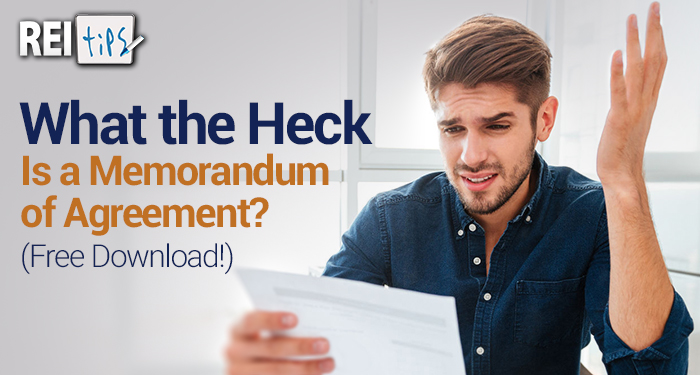This is a critical document that can help you in your own short sales.
A Memorandum of WHAT?
A Memorandum of Agreement protects your interests as the buyer. It’s a form you will only need in certain cases, but one you should always keep on hand.
If you think you have a squirrely seller who may not make good on their end of the deal, a memorandum of agreement clouds the title so other interested parties can’t buy it. It basically gives public notice that you have an agreement to purchase the property from the homeowner.
So technically, once this form is filed, the homeowner is not supposed to be able to sell the house unless this Memorandum of Agreement is wiped away.
It is possible to sell a property with a Memorandum of Agreement filed against it, but most people don’t know that and the memorandum is usually enough to protect you.
Why Use a Memorandum of Agreement?
If you’ve ever worked with a homeowner who was not necessarily ready to sign over the deed, this form can come in handy. If you don’t get the deed signed at the initial meeting, you are opening yourself up to potential problems.
But if you and the homeowner are on the same page about your expectations, not having a deed doesn’t necessarily mean no deal….
And that’s where the Memorandum of Agreement comes in. If you don’t get a deed signed, the Memorandum of Agreement can act as a sort of generic version of recording the deed.
It doesn’t give you ownership rights by any means, but it puts a cloud on the title just enough to where the homeowner can’t sell the property without your permission.
Like I said, this is not foolproof, it’s just something to get as a backup. So get it.
The Details
The memorandum is a 1-page form that requires party names and contact information.
The first section states that 2 parties have entered into an agreement to sell/buy a property. You will need to provide:
 The homeowner’s name (the homeowner is known as the obligor)
The homeowner’s name (the homeowner is known as the obligor) The purchaser’s name (the purchaser is the obligee)
The purchaser’s name (the purchaser is the obligee)
For example, if you are doing a short sale transfer into a land trust, you will include the information for the trust in the obligee sections.
Then you will include:
 The address of the property for sale
The address of the property for sale The purchaser’s contact information
The purchaser’s contact information
Then, have the homeowner sign and date the document, and you’re done.
In some states, all documents must be notarized in order to be recorded, so make sure you find out whether you also need to notarize this document before you bring it in. If you’re not sure, give your courthouse or the powers that be in your county a call to find out.
Remember, if you already have a deed you don’t need this form. Recording this on top of the deed would be a waste of your time and money.
If you need to explain why you want the homeowner to fill out this form, let them know that you are going to be putting blood, sweat and tears into this deal, working hard to get it done. The last thing you both need is something else coming up to expose you to any unnecessary risks.
Your Take
Will you be using the Memorandum of Agreement in your next non-deed deal? Give me a shout-out below and let me know!





Yes, I will be using it. People have gone around my back and worked the deal with the sellers.
It has made it very difficult to get my business going, and caused a great deal of discouragement and mistrust of most if not all people.
It’s not downloading. How do I get the doc.
The download is made available via email after providing your name and email address.
If the contract to purchase has expired does this also mean the recorded memorandum expires